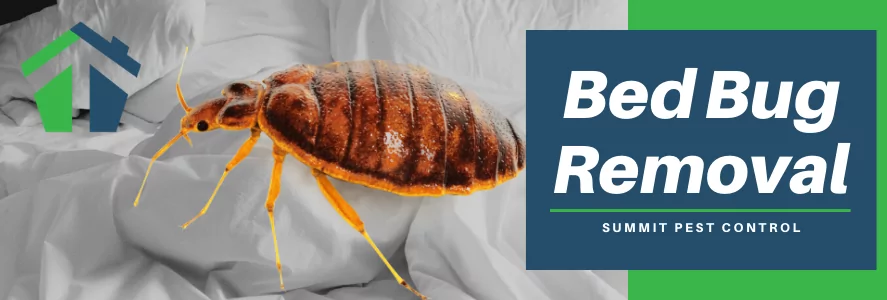Bed Bug Removal and Control in Fredericksburg, Fairfax, Alexandria & Arlington, VA
Bed Bug Characteristics
Bed bugs are an insect in the Family Cimicidae, Order Hemiptera, known as “true bugs.” The common bed bug, Cimex Lectularius is a reddish brown-colored insect that has piercing and sucking mouthparts so they can feed off the blood of animals and people. These mouthparts are called a “proboscis” and contain a cutting structure called “stylets” that cut open and allow the proboscis to be inserted into the skin and siphon blood as a meal. Glands in the head of the insect secrete an anticoagulant that will keep the blood from clotting and flowing freely while the insect feeds. This secretion can cause irritation to the victims skin resulting in redness, rashes, and or pustules at the bite location. Complications with infection can occur due to scratching these wounds due to their itchiness and discomfort.
The Common Bed Bug
This insect has a lifecycle that is termed incomplete or gradual. This means they do not experience a metamorphosis like a butterfly, but start as an egg, emerge and go through approximately five nymphal stages with very little change to their appearance other than size. The eggs are whitish and about .04 inches long with the first hatchlings about that same size and gradually increasing in size at each stage until the adult stage. Adults are 1/5th to ¼” long and approximately ⅛ “ wide. They are a shield shaped insect that is red to reddish-brown or mahogany colored. They have no wings. Antennae are four segments and easily visible where the mouthparts are tucked under the insect and not apparent. Their bodies are flat and they have the ability to move quickly but can’t fly. Bed bugs require blood to survive and must feed on blood to develop eggs, mate, and complete their development.
Schedule a FREE
Estimate
Fields with (*) are required.
Fields with (*) are required.
Biology
Shortly following molting, the bed bug will seek out a host to feed. Once they become adults they begin to mate with recently fed females which feed approximately once per week. Egg laying can be as short as three days following a blood meal and mating. The female will lay eggs on rough structures and glue them in place. The life span of these insects is six to 12 months and in that time can produce up to 200 eggs at about a two per day average. Eggs hatch as quickly as 10 days after being laid. The total cycle from adult to adult is an average of 52 days. These insects have adapted for survival from their hiding (cryptic) behavior to the ability to go extended periods of time without feeding. Sometimes as long as one year without food. They are however more susceptible to temperatures than other species. Temperatures lower than 32℉ for more than two days or higher than 120℉ for more than a couple hours will result in their death.
Behavior
They enter homes by clinging to people’s clothing, luggage or furniture. They will hide in bed frames, box springs, mattresses and headboards and will feed off of the blood of people and animals (dogs, cats, bats, or birds) at night, while people and animals are sleeping. Most often, people will pick up bed bugs during a stay in a hotel and will bring them home with them, although bed bugs can make their way into your home in a variety of different ways. Bed bugs can detect hosts from up to five feet away and track them from their breathing (CO2) and body heat. They are actually attracted to heat up to 109℉ but usually avoid higher temps.
Bites: bed bugs usually attack exposed skin of sleeping mammals and humans. The arms, legs, backs, abdomen and face are common targets. The bites seem to manifest in lines as the insects take successive meals. Bites can become infected from scratching and people can develop sensitivity after being bitten frequently.
They can move quickly at about four feet per minute and traverse substantial distances in search of habitat and hosts. Adjoining rooms to any infested area can quickly become infested. In high populations, aggregation of bed bugs (insects, fecal matter, blood stains) can be seen or easily discovered on the mattress, headboard, adjacent furniture, window trim and treatments, outlets, under carpets and rugs, toys, electronics, and picture frames to name just a few.
How to Get Rid of Bed Bugs丨Summit Pest Control
Bed bugs are and have been plaguing humans since prehistoric times and for a number of decades, industrialized nations had all but eliminated them as a consistent pest. Recently, starting in the 1990’s we’ve seen a worldwide resurgence due to ease and speed of international travel and immigration. Therefore the art and science of bed bug control has seen a resurgence including new effective non chemical technologies
There are various ways to get rid of bed bugs, but the best and most effective way is to hire a pest control company. Pest control companies have access to professional-grade chemicals which are more potent than what they offer on the market. Other methods may involve non chemical treatments such as heat, cryogenic, and vacuuming as methods to eliminate or greatly reduce populations, but inevitably, chemical based control procedures are the basic standard of control and elimination.
The pest control technician will advise you to wash your clothes, bedding and other linens in the hottest water setting and dry them on the highest setting. All of your cloth belongings will then need to be placed in garbage bags while the treatment is happening. The technician will spray for the bed bugs and you and your family and pets cannot return to the home until the spray is dry. It is not harmful for you or pets, but may cause an upset stomach if accidentally ingested. Bed bugs are not known for spreading any diseases, however, they can be extremely annoying and cause discomfort to the members of the household.
Bed Bug Prevention and Control in Northern Virginia
Some preventative measures you can take for bed bugs are keeping your home clean, vacuuming often, changing sheets often and inspecting for bed bugs. Using a mattress protector will also help to keep bed bugs away. It is advised to wash pillows, mattresses and bedding regularly and replace them after a certain number of years. When staying at a hotel, check the room and bedding for signs of bed bugs. Do not stay in a room where there are bed bugs. Additionally, when coming home from a stay at a hotel, check your luggage and clothing before going inside and make sure to wash your clothes immediately.
How Much Does Bed Bug Removal Cost?
Removing bed bugs from your home is not a simple feat. Typically it will take more than one treatment to get the infestation under control and it is best to treat the entire home in case the bed bugs have moved to different areas. The cost to remove bed bugs from your home is variable, because it is dependent on the number of rooms that need to be treated, the intensity of the treatment (how much chemical is used) and the amount of treatments needed to rid the home of fleas. A pest control specialist will be able to determine a treatment plan during the initial inspection and will give you a price then.
How Do I Prepare My Home for a Bug Bug Treatment?
Summit has created a handy pre bed bug treatment checklist for your convenience. You’ll be fully prepared for your bed bug treatment. You can view the full pre-treatment checklist here: Bed Bug Pre-Treatment Checklist
Why should I address my Bed Bug Problem?
Bed bugs should be removed because not only are they a nuisance to you and your family, they are also not supposed to live in your home. Despite their name, bed bugs belong outside. For more information about bed bug removal and bed bug control in Fredericksburg, Fairfax, Alexandria, Arlington and other parts of Northern Virginia, contact us today at 703-884-2124.
Contact Summit Wildlife Removal for Animal Removal, in Fredericksburg, Fairfax, Alexandria & Arlington, VA.
Contact us online or give us a call at 703-884-2124 when you need our services. For dog or cat issues, contact your local municipal animal control office.













